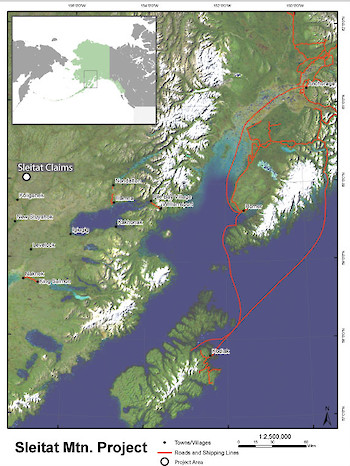Click To Enlarge
The Sleitat Tin-Silver Property
The Sleitat property is comprised of the CAS 1 through 22 State of Alaska mining claims totalling 1,425 hectares (3,520 acres). The property is located in an uninhabited remote area within the boundaries of the Bristol Bay Native Corporation and can be accessed by helicopter from Dillingham roughly 137 kilometers to the southwest or Iliamna roughly 275 kilometers to the east-southeast.
The Kuskokwim Mountains region (which in this case includes the northwest part of the Alaska Range) was targeted in 1983 by Cominco American Inc. ("Cominco") for the exploration of Bolivian-style tin deposits. Tin enrichment was discovered at the Sleitat prospect in association with sheeted, east-west trending greisen alteration. The greisen alteration extends across all phases of the highly evolved Sleitat granite stock and into the surrounding hornfelsed sediments. The Sleitat granite is massive, exhibits no internal preferred orientation and is comprised of biotite granite, biotite-muscovite granite, and zinnwaldite granite (St. George, 1985). Minor felsic dykes are noted around the intrusive boundary. The Sleitat granites have geochemical characteristics similar to the average tin-granite; namely a progression from the marginal biotite granite through to the zinnwaldite granite.
Cominco was active on the property in 1983, 1984 and 1988 when it identified the granitic intrusives and hornfelsed sediments on the property as prospective for tin-silver greisen deposits, and conducted various geological, rock and soil geochemical and geophysical surveys. Cominco also completed a total of 723.8 meters of BQ core drilling in 9 holes on the Sleitat project (a 10th hole was abandoned) during 1984 and 1988. The Cominco drill results indicate that the majority of the tin mineralization is hosted in steeply dipping tabular greisen bodies, separated by altered, but relatively barren zones of granite. The greisen zones are concentrated in two zones at the northern and southern margins of the Sleitat stock. High-grade brecciated greisen zones also exist in the system, as demonstrated in hole Cass 84-06 which intersected 3.1 meters 12.55% Sn and 197.5 g/t Ag in re-sampled quartered core.
In 1989 the USBM evaluated the tin resource potential of the Sleitat property and inferred a "resource" of 28.6 million short tons (25.9Mt) of mineralized rock at a grade of 0.224 to 0.37% Sn, 0.04% W, and 17 g/t Ag based on representative surface samples and a depth projection based on Cominco drill holes (Burleigh, 1990). Burleigh's calculated "inferred resource" is an historic estimate and can only be considered conceptual as it does not meet the minimum requirements for classification as a Canadian Institute for Mining, Metallurgy and Petroleum ("CIM") standard mineral resource.
This historic estimate is not current and is not compliant with CIM standard definitions. A qualified person has not done sufficient work to classify this historical estimate as current mineral resources and Cornish Metals is not treating the historical estimate as current mineral resources. The calculations have not been verified and they are not reconcilable with current resource categories as specified by CIM standard definitions. A qualified person has not evaluated this historic estimate on behalf of Cornish Metals and comment cannot be made with respect to what work needs to be done to upgrade or verify the historical estimate as current mineral resources. This historical estimate is reported here for information purposes only and should not be relied upon.
Based on review and confirmation of historic results and conclusions, two significant tin-silver targets were identified that were deemed to warrant further exploration drilling, including:
- The northern greisen, where all the Cominco drilling was completed, is open to the east, west and at depth; and,
- The untested southern greisen is hosted in hornfels rock along the south intrusive margin and could be indicative of an unroofed greisen zone or even a deeper cupola intrusive phase with associated roof greisen mineralization.
The 2005 stream sediment samples showed strong to highly anomalous tin and tungsten results peripheral to the mapped stock. Samples to the northwest, southwest and southeast suggest the mineralization could extend beyond the mapped greisenized granitic stock.
In 2006 Brett Resources drilled 5 additional BTW core holes totaling 702.5 meters (2,305 feet), one of which twinned one of the earlier Cominco drill holes. Mr. Ellis of AES supervised this July 2006 drilling program which targeted the mineralized northern greisen and further substantiated the Cominco results indicating the presence of significant tin-silver mineralized greisen within the granitic intrusives.
In 2011 Osisko contracted AES to conduct an assessment mapping and sampling program that focused primarily on areas peripheral to the Sleitat stock that included pan concentrate sampling. This exploration work did confirm significant highly anomalous tin and tungsten anomalies that warrant follow-up prospecting and sampling.
There appears to be up-side potential to extend the tin-silver mineralization at the north greisen zone and define additional tin-silver mineralization in the untested south greisen zone at the Sleitat prospect. Scattered cassiterite bearing quartz veins have been noted in the hornfels peripheral to the Sleitat stock along with narrow rhyolite porphyry dikes. That coupled with very anomalous tin and tungsten pan and sediment samples to the northwest, southwest, and southeast in hornfelsed sediments suggest areas that are prospective for buried tin bearing intrusions. A large airborne magnetic anomaly occurs on and to the southeast of the claims suggesting the presence a shallowly buried intrusion.
Royalty Agreement
On May 29, 2022 Cornish Metals completed the sale of a 1% Net Smelter Return royalty on the Sleitat tin-silver project, located in Alaska, USA, to Electric Royalties Ltd (TSX-V: ELEC) in return for $100,000 cash and 1,000,000 common shares of Electric (“Consideration Shares”) (see news release dated March 10, 2022).



